Research Report: Addressing Language Barriers in Hospital Settings
VerifiedAdded on 2022/09/11
|22
|3248
|9
Report
AI Summary
This report, authored by a student enrolled nurse, investigates language barriers in hospital settings, focusing on the challenges faced by non-English speaking patients and healthcare providers. The research addresses the need to enhance communication and improve patient care, driven by the Enrolled Nurses Standards of Practice and the Code of Ethics for Nurses in Australia. The study explores the efficacy of medical interpreter services in eliminating language barriers through a narrative review of literature, examining databases such as CINAHL and PubMed. The methodology involves the identification of relevant keywords, inclusion and exclusion criteria, and the application of the JBI tool for methodological quality assessment. The findings from four selected articles highlight the positive impact of interpreter services on communication, reduced hospital expenditure and readmission rates, and improved stroke care outcomes. The report concludes that hiring professional medical interpreters significantly enhances communication, preventing errors and facilitating effective patient care. The report also references studies by Karliner, Pérez-Stable and Gregorich (2017), Luan Erfe et al. (2017), Hamai, Nagata and Nishikawa (2017), and Jacobs et al. (2018).
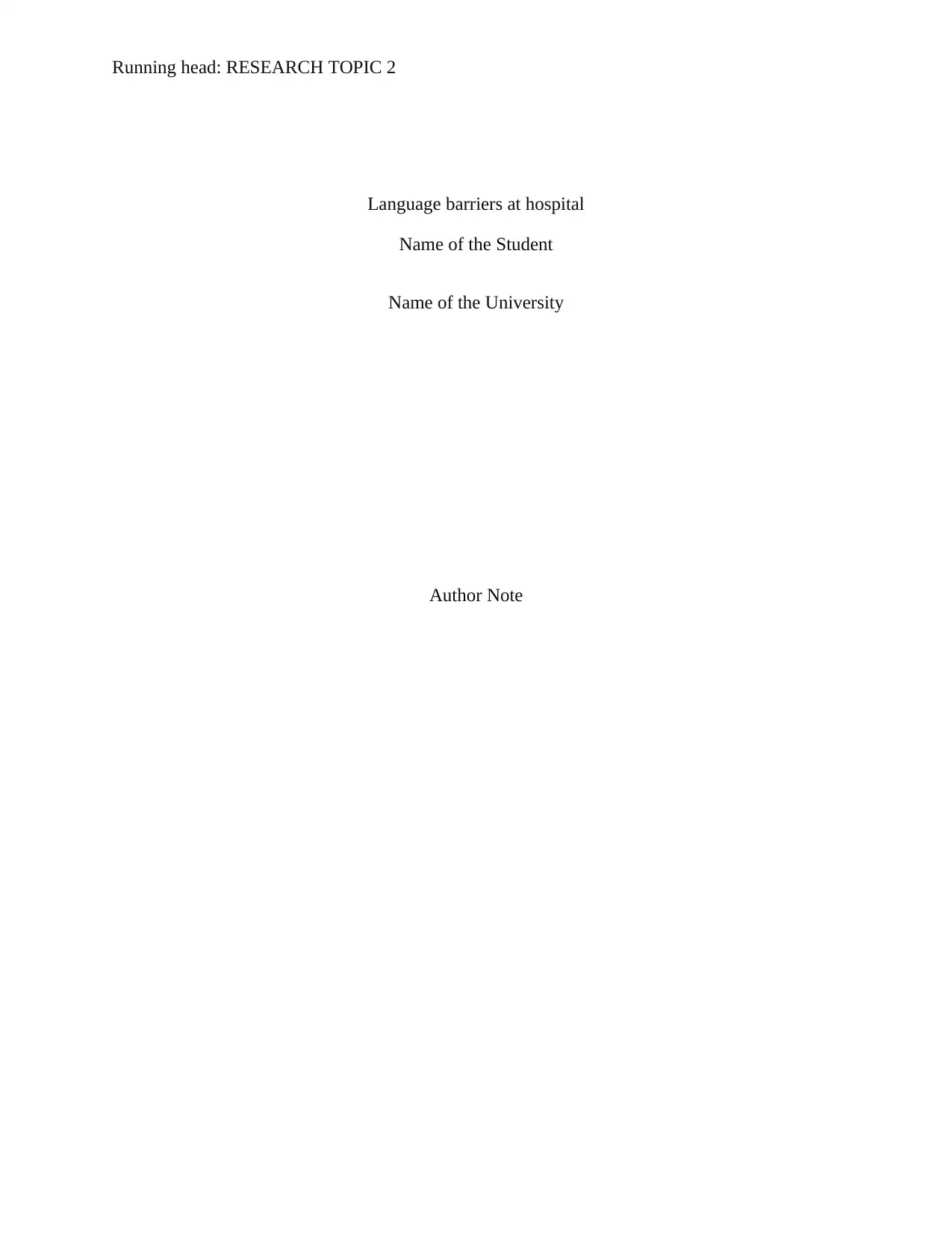
Running head: RESEARCH TOPIC 2
Language barriers at hospital
Name of the Student
Name of the University
Author Note
Language barriers at hospital
Name of the Student
Name of the University
Author Note
Paraphrase This Document
Need a fresh take? Get an instant paraphrase of this document with our AI Paraphraser
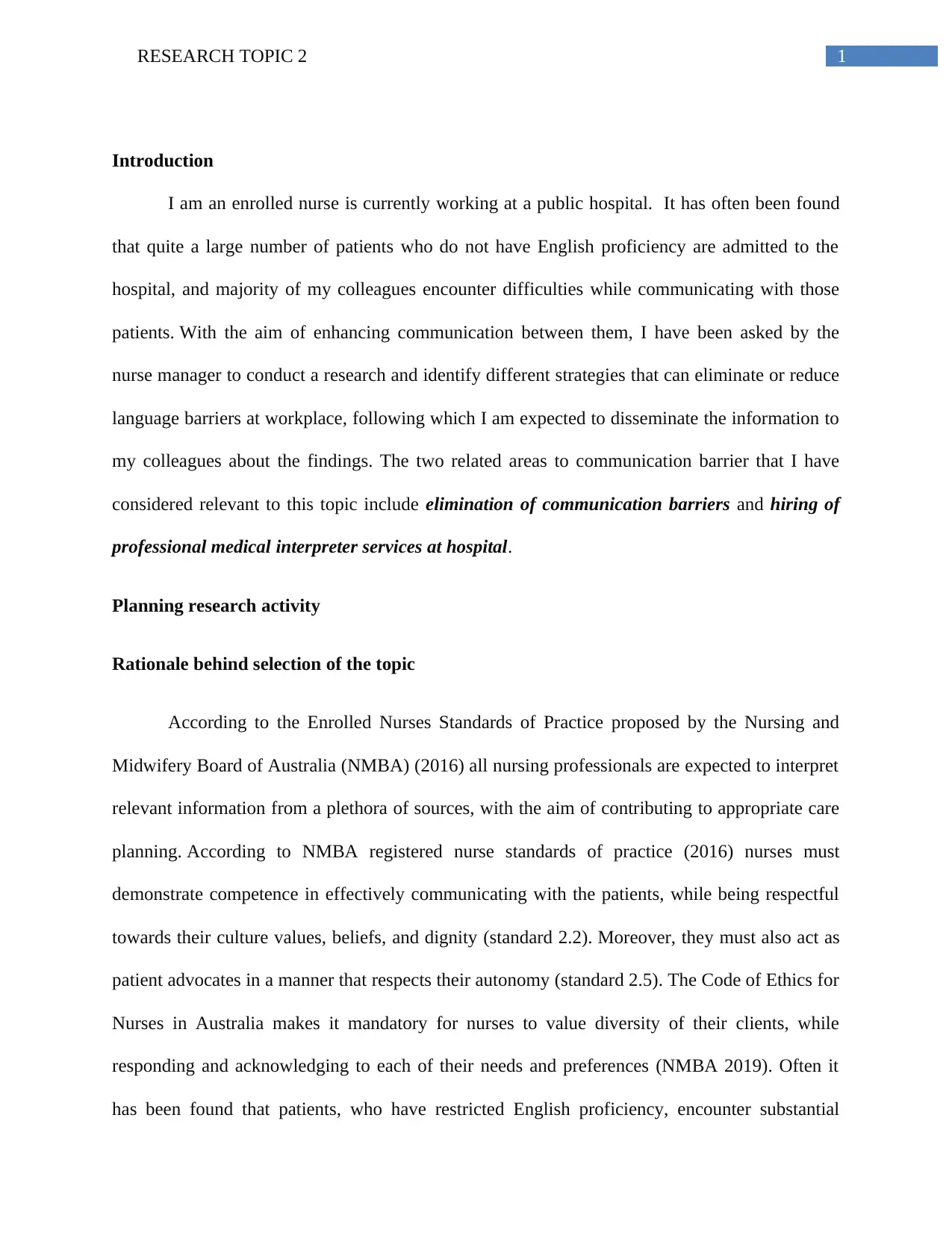
1RESEARCH TOPIC 2
Introduction
I am an enrolled nurse is currently working at a public hospital. It has often been found
that quite a large number of patients who do not have English proficiency are admitted to the
hospital, and majority of my colleagues encounter difficulties while communicating with those
patients. With the aim of enhancing communication between them, I have been asked by the
nurse manager to conduct a research and identify different strategies that can eliminate or reduce
language barriers at workplace, following which I am expected to disseminate the information to
my colleagues about the findings. The two related areas to communication barrier that I have
considered relevant to this topic include elimination of communication barriers and hiring of
professional medical interpreter services at hospital.
Planning research activity
Rationale behind selection of the topic
According to the Enrolled Nurses Standards of Practice proposed by the Nursing and
Midwifery Board of Australia (NMBA) (2016) all nursing professionals are expected to interpret
relevant information from a plethora of sources, with the aim of contributing to appropriate care
planning. According to NMBA registered nurse standards of practice (2016) nurses must
demonstrate competence in effectively communicating with the patients, while being respectful
towards their culture values, beliefs, and dignity (standard 2.2). Moreover, they must also act as
patient advocates in a manner that respects their autonomy (standard 2.5). The Code of Ethics for
Nurses in Australia makes it mandatory for nurses to value diversity of their clients, while
responding and acknowledging to each of their needs and preferences (NMBA 2019). Often it
has been found that patients, who have restricted English proficiency, encounter substantial
Introduction
I am an enrolled nurse is currently working at a public hospital. It has often been found
that quite a large number of patients who do not have English proficiency are admitted to the
hospital, and majority of my colleagues encounter difficulties while communicating with those
patients. With the aim of enhancing communication between them, I have been asked by the
nurse manager to conduct a research and identify different strategies that can eliminate or reduce
language barriers at workplace, following which I am expected to disseminate the information to
my colleagues about the findings. The two related areas to communication barrier that I have
considered relevant to this topic include elimination of communication barriers and hiring of
professional medical interpreter services at hospital.
Planning research activity
Rationale behind selection of the topic
According to the Enrolled Nurses Standards of Practice proposed by the Nursing and
Midwifery Board of Australia (NMBA) (2016) all nursing professionals are expected to interpret
relevant information from a plethora of sources, with the aim of contributing to appropriate care
planning. According to NMBA registered nurse standards of practice (2016) nurses must
demonstrate competence in effectively communicating with the patients, while being respectful
towards their culture values, beliefs, and dignity (standard 2.2). Moreover, they must also act as
patient advocates in a manner that respects their autonomy (standard 2.5). The Code of Ethics for
Nurses in Australia makes it mandatory for nurses to value diversity of their clients, while
responding and acknowledging to each of their needs and preferences (NMBA 2019). Often it
has been found that patients, who have restricted English proficiency, encounter substantial
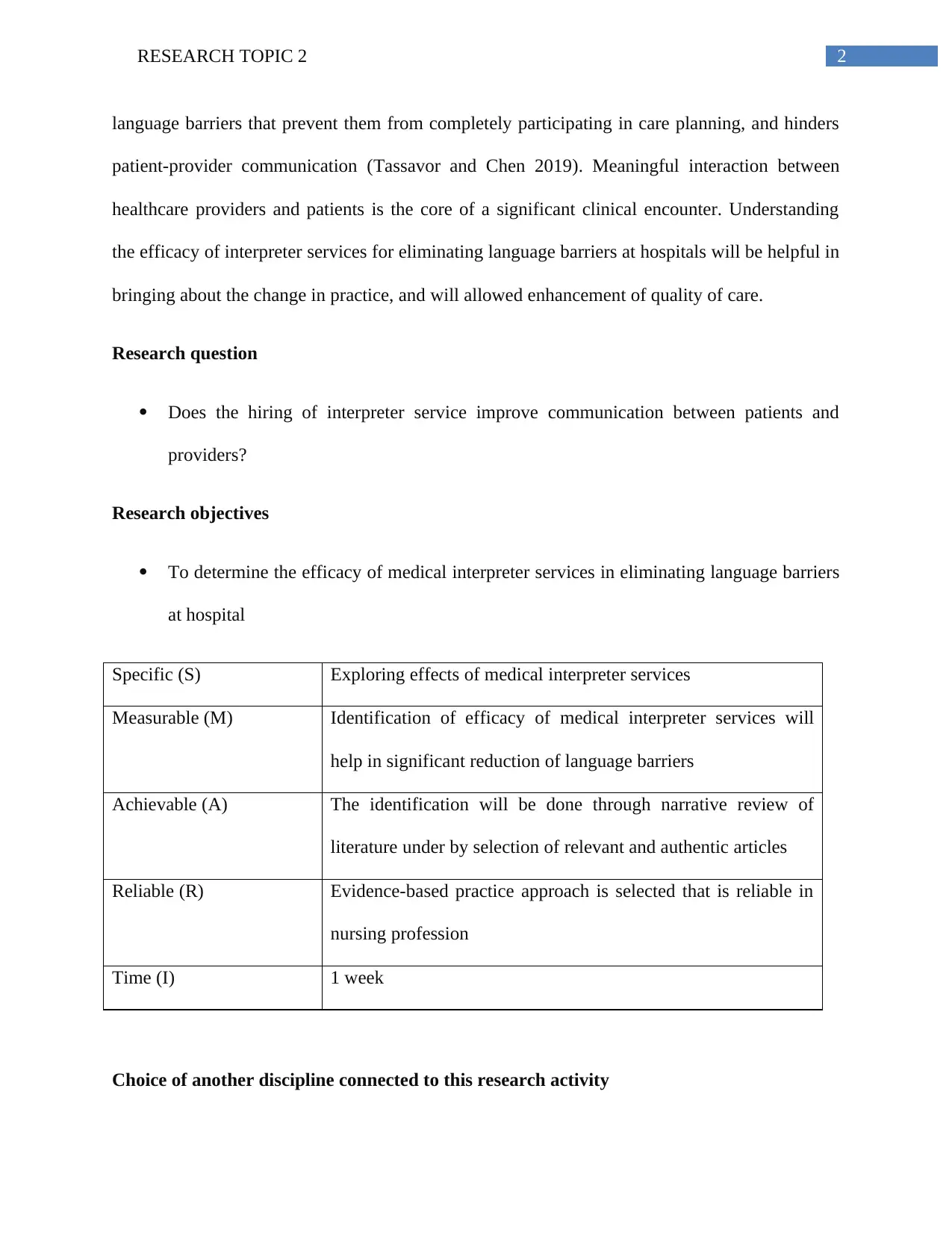
2RESEARCH TOPIC 2
language barriers that prevent them from completely participating in care planning, and hinders
patient-provider communication (Tassavor and Chen 2019). Meaningful interaction between
healthcare providers and patients is the core of a significant clinical encounter. Understanding
the efficacy of interpreter services for eliminating language barriers at hospitals will be helpful in
bringing about the change in practice, and will allowed enhancement of quality of care.
Research question
Does the hiring of interpreter service improve communication between patients and
providers?
Research objectives
To determine the efficacy of medical interpreter services in eliminating language barriers
at hospital
Specific (S) Exploring effects of medical interpreter services
Measurable (M) Identification of efficacy of medical interpreter services will
help in significant reduction of language barriers
Achievable (A) The identification will be done through narrative review of
literature under by selection of relevant and authentic articles
Reliable (R) Evidence-based practice approach is selected that is reliable in
nursing profession
Time (I) 1 week
Choice of another discipline connected to this research activity
language barriers that prevent them from completely participating in care planning, and hinders
patient-provider communication (Tassavor and Chen 2019). Meaningful interaction between
healthcare providers and patients is the core of a significant clinical encounter. Understanding
the efficacy of interpreter services for eliminating language barriers at hospitals will be helpful in
bringing about the change in practice, and will allowed enhancement of quality of care.
Research question
Does the hiring of interpreter service improve communication between patients and
providers?
Research objectives
To determine the efficacy of medical interpreter services in eliminating language barriers
at hospital
Specific (S) Exploring effects of medical interpreter services
Measurable (M) Identification of efficacy of medical interpreter services will
help in significant reduction of language barriers
Achievable (A) The identification will be done through narrative review of
literature under by selection of relevant and authentic articles
Reliable (R) Evidence-based practice approach is selected that is reliable in
nursing profession
Time (I) 1 week
Choice of another discipline connected to this research activity
⊘ This is a preview!⊘
Do you want full access?
Subscribe today to unlock all pages.

Trusted by 1+ million students worldwide
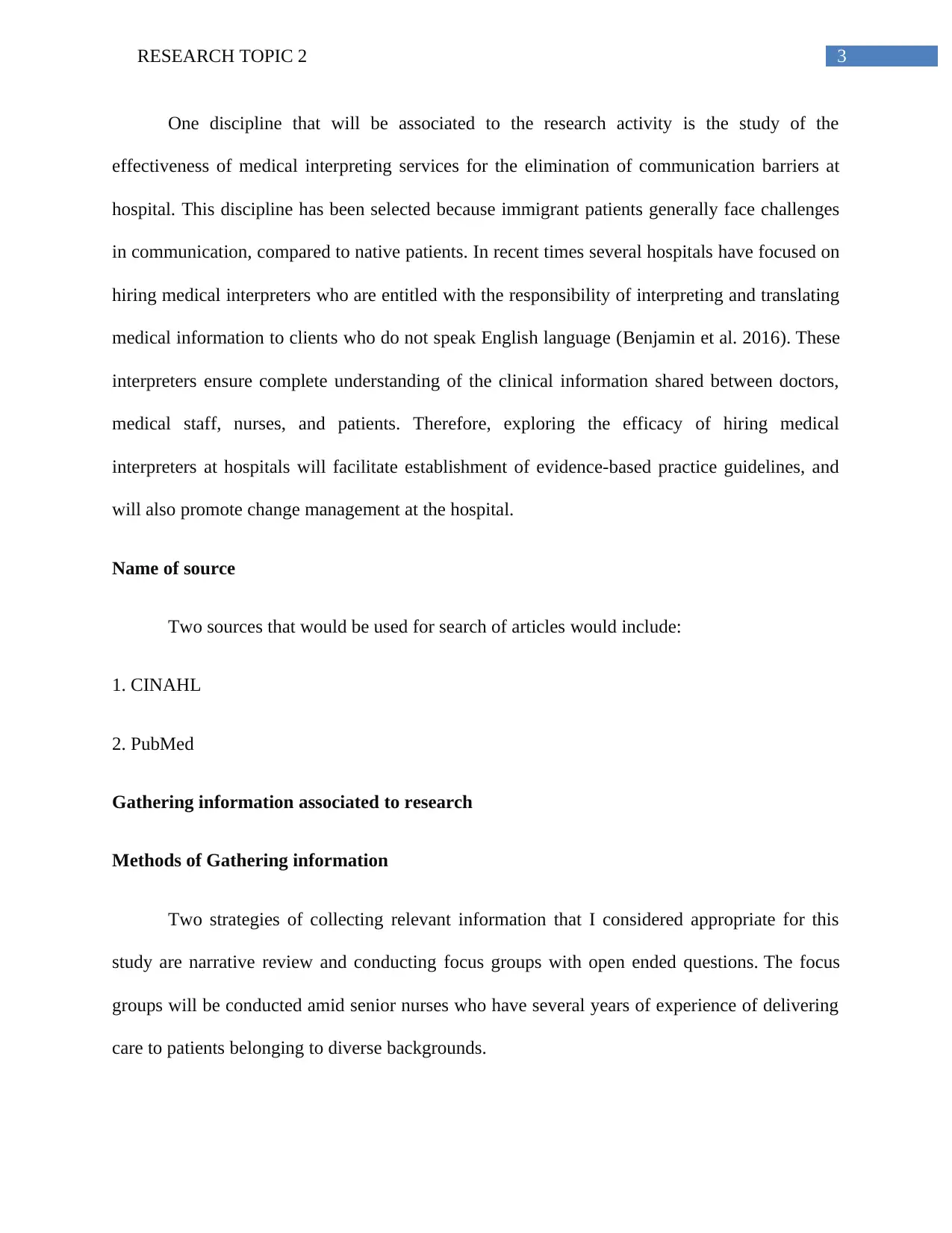
3RESEARCH TOPIC 2
One discipline that will be associated to the research activity is the study of the
effectiveness of medical interpreting services for the elimination of communication barriers at
hospital. This discipline has been selected because immigrant patients generally face challenges
in communication, compared to native patients. In recent times several hospitals have focused on
hiring medical interpreters who are entitled with the responsibility of interpreting and translating
medical information to clients who do not speak English language (Benjamin et al. 2016). These
interpreters ensure complete understanding of the clinical information shared between doctors,
medical staff, nurses, and patients. Therefore, exploring the efficacy of hiring medical
interpreters at hospitals will facilitate establishment of evidence-based practice guidelines, and
will also promote change management at the hospital.
Name of source
Two sources that would be used for search of articles would include:
1. CINAHL
2. PubMed
Gathering information associated to research
Methods of Gathering information
Two strategies of collecting relevant information that I considered appropriate for this
study are narrative review and conducting focus groups with open ended questions. The focus
groups will be conducted amid senior nurses who have several years of experience of delivering
care to patients belonging to diverse backgrounds.
One discipline that will be associated to the research activity is the study of the
effectiveness of medical interpreting services for the elimination of communication barriers at
hospital. This discipline has been selected because immigrant patients generally face challenges
in communication, compared to native patients. In recent times several hospitals have focused on
hiring medical interpreters who are entitled with the responsibility of interpreting and translating
medical information to clients who do not speak English language (Benjamin et al. 2016). These
interpreters ensure complete understanding of the clinical information shared between doctors,
medical staff, nurses, and patients. Therefore, exploring the efficacy of hiring medical
interpreters at hospitals will facilitate establishment of evidence-based practice guidelines, and
will also promote change management at the hospital.
Name of source
Two sources that would be used for search of articles would include:
1. CINAHL
2. PubMed
Gathering information associated to research
Methods of Gathering information
Two strategies of collecting relevant information that I considered appropriate for this
study are narrative review and conducting focus groups with open ended questions. The focus
groups will be conducted amid senior nurses who have several years of experience of delivering
care to patients belonging to diverse backgrounds.
Paraphrase This Document
Need a fresh take? Get an instant paraphrase of this document with our AI Paraphraser
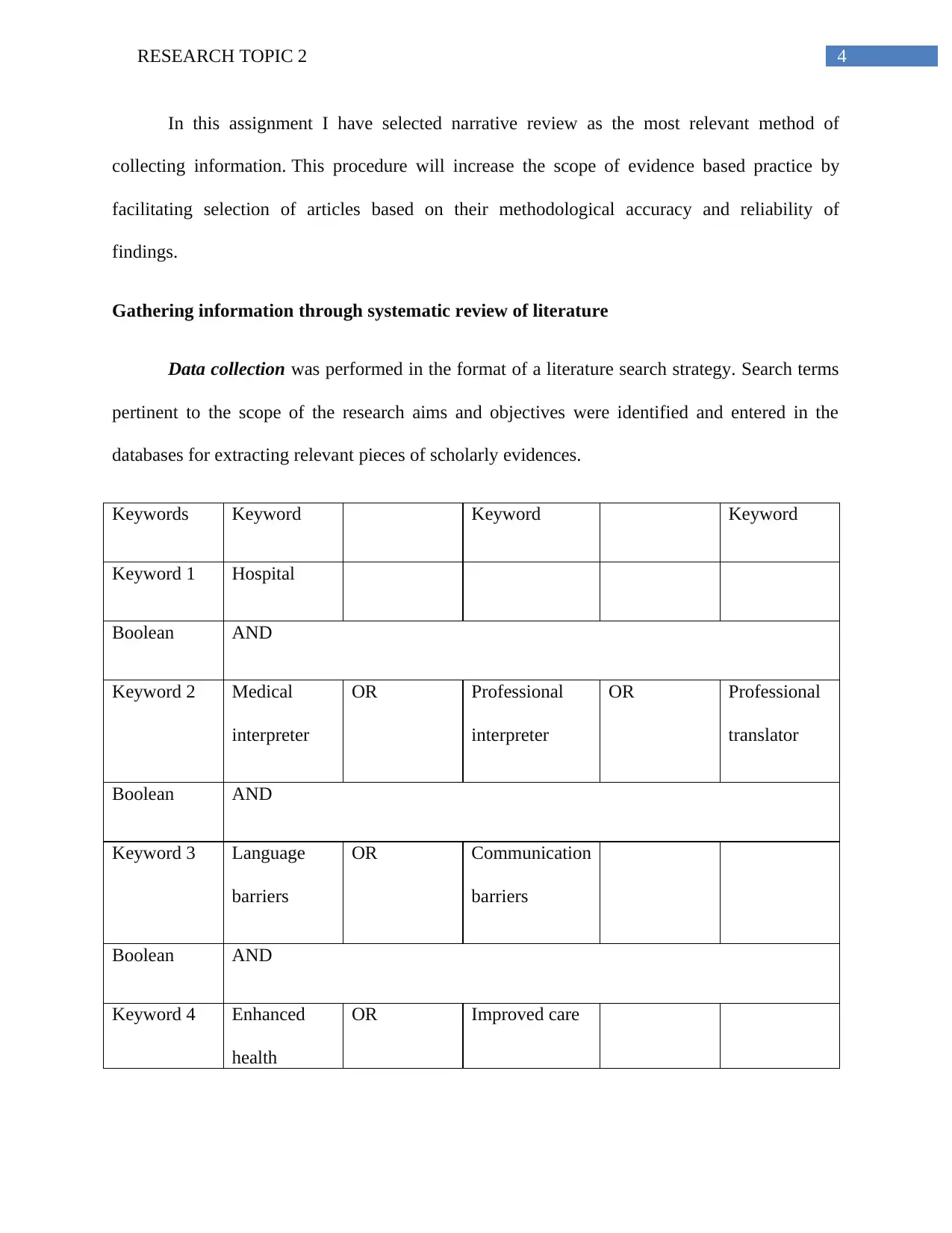
4RESEARCH TOPIC 2
In this assignment I have selected narrative review as the most relevant method of
collecting information. This procedure will increase the scope of evidence based practice by
facilitating selection of articles based on their methodological accuracy and reliability of
findings.
Gathering information through systematic review of literature
Data collection was performed in the format of a literature search strategy. Search terms
pertinent to the scope of the research aims and objectives were identified and entered in the
databases for extracting relevant pieces of scholarly evidences.
Keywords Keyword Keyword Keyword
Keyword 1 Hospital
Boolean AND
Keyword 2 Medical
interpreter
OR Professional
interpreter
OR Professional
translator
Boolean AND
Keyword 3 Language
barriers
OR Communication
barriers
Boolean AND
Keyword 4 Enhanced
health
OR Improved care
In this assignment I have selected narrative review as the most relevant method of
collecting information. This procedure will increase the scope of evidence based practice by
facilitating selection of articles based on their methodological accuracy and reliability of
findings.
Gathering information through systematic review of literature
Data collection was performed in the format of a literature search strategy. Search terms
pertinent to the scope of the research aims and objectives were identified and entered in the
databases for extracting relevant pieces of scholarly evidences.
Keywords Keyword Keyword Keyword
Keyword 1 Hospital
Boolean AND
Keyword 2 Medical
interpreter
OR Professional
interpreter
OR Professional
translator
Boolean AND
Keyword 3 Language
barriers
OR Communication
barriers
Boolean AND
Keyword 4 Enhanced
health
OR Improved care
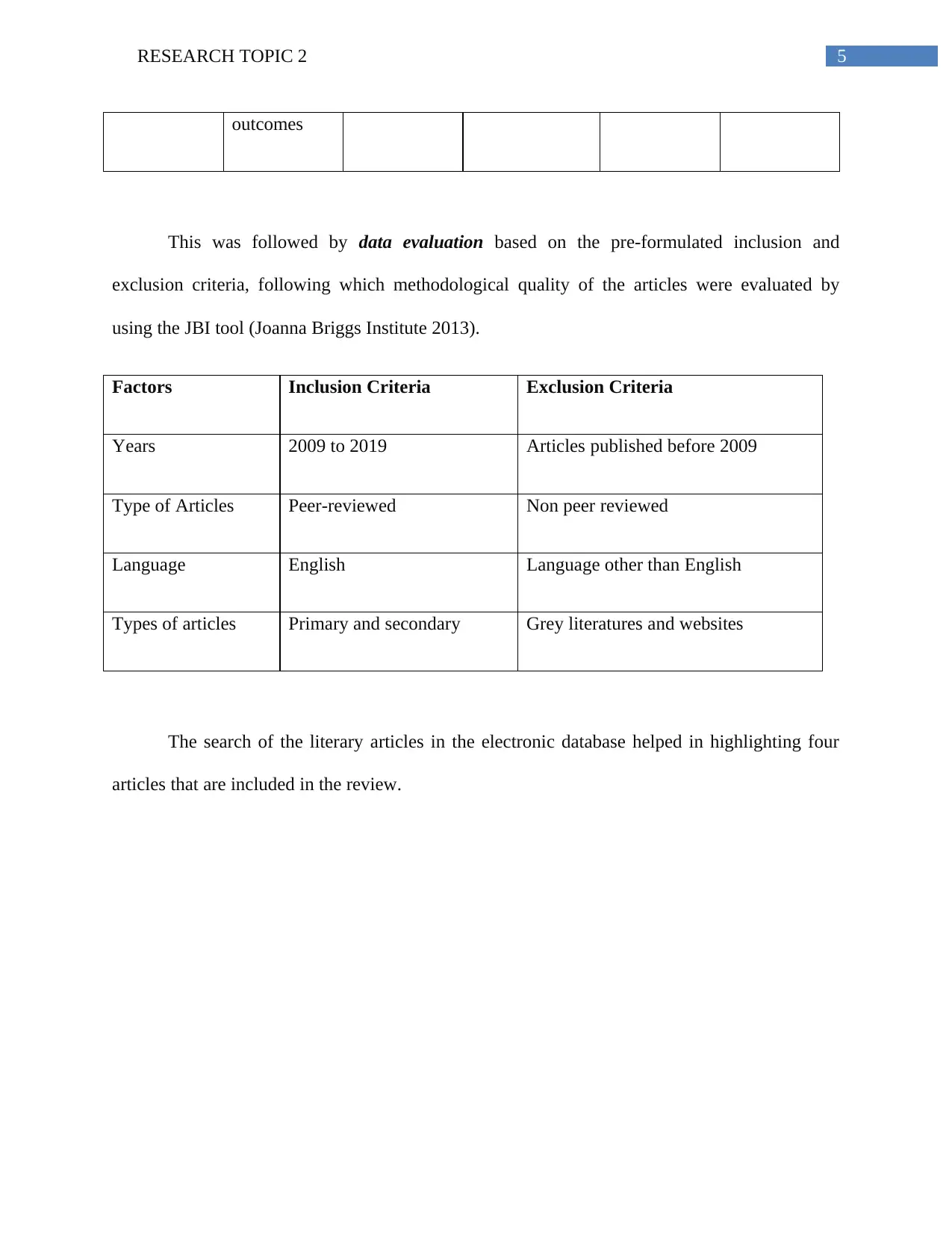
5RESEARCH TOPIC 2
outcomes
This was followed by data evaluation based on the pre-formulated inclusion and
exclusion criteria, following which methodological quality of the articles were evaluated by
using the JBI tool (Joanna Briggs Institute 2013).
Factors Inclusion Criteria Exclusion Criteria
Years 2009 to 2019 Articles published before 2009
Type of Articles Peer-reviewed Non peer reviewed
Language English Language other than English
Types of articles Primary and secondary Grey literatures and websites
The search of the literary articles in the electronic database helped in highlighting four
articles that are included in the review.
outcomes
This was followed by data evaluation based on the pre-formulated inclusion and
exclusion criteria, following which methodological quality of the articles were evaluated by
using the JBI tool (Joanna Briggs Institute 2013).
Factors Inclusion Criteria Exclusion Criteria
Years 2009 to 2019 Articles published before 2009
Type of Articles Peer-reviewed Non peer reviewed
Language English Language other than English
Types of articles Primary and secondary Grey literatures and websites
The search of the literary articles in the electronic database helped in highlighting four
articles that are included in the review.
⊘ This is a preview!⊘
Do you want full access?
Subscribe today to unlock all pages.

Trusted by 1+ million students worldwide
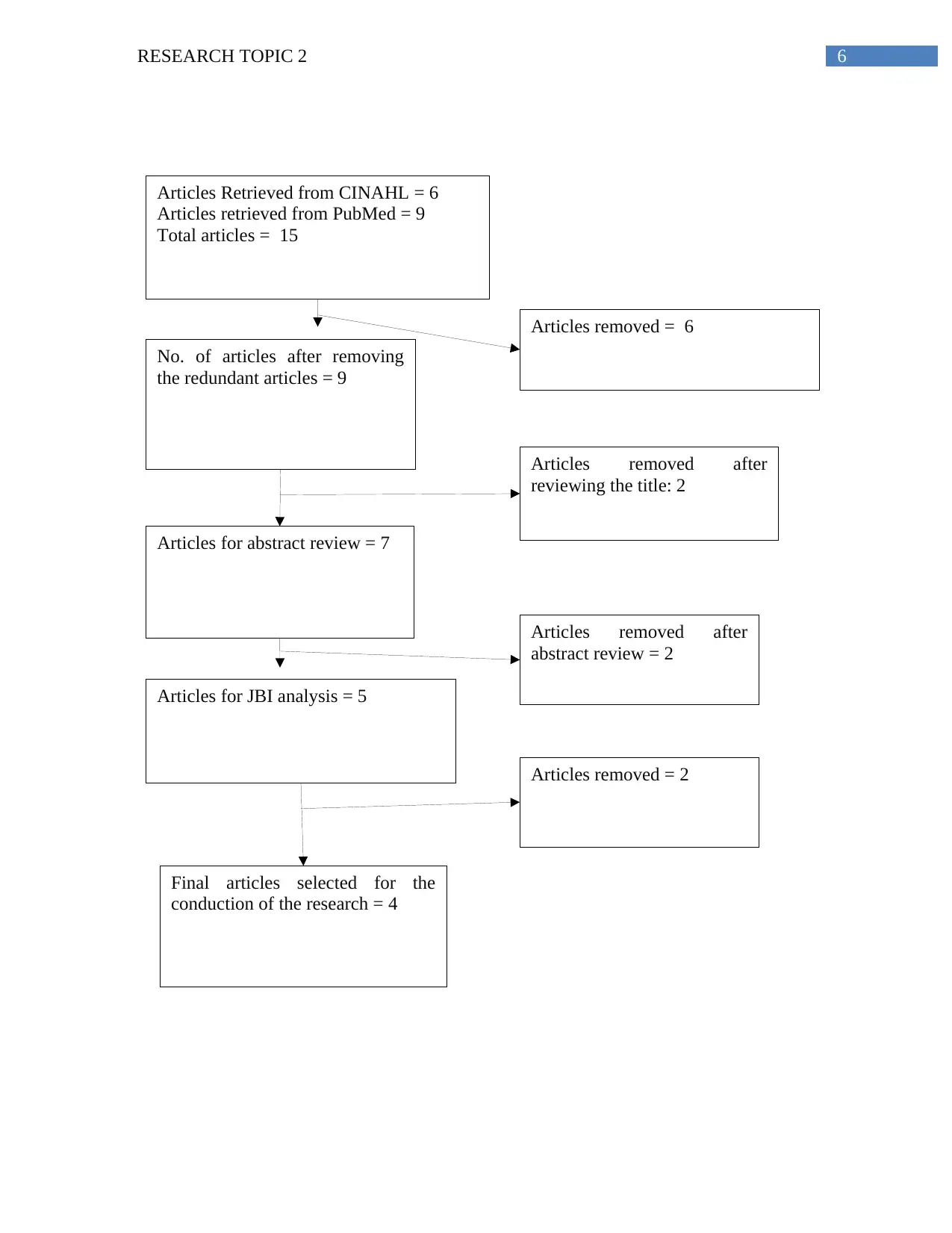
6RESEARCH TOPIC 2
Articles Retrieved from CINAHL = 6
Articles retrieved from PubMed = 9
Total articles = 15
Articles removed = 6
No. of articles after removing
the redundant articles = 9
Articles for abstract review = 7
Articles for JBI analysis = 5
Final articles selected for the
conduction of the research = 4
Articles removed after
reviewing the title: 2
Articles removed after
abstract review = 2
Articles removed = 2
Articles Retrieved from CINAHL = 6
Articles retrieved from PubMed = 9
Total articles = 15
Articles removed = 6
No. of articles after removing
the redundant articles = 9
Articles for abstract review = 7
Articles for JBI analysis = 5
Final articles selected for the
conduction of the research = 4
Articles removed after
reviewing the title: 2
Articles removed after
abstract review = 2
Articles removed = 2
Paraphrase This Document
Need a fresh take? Get an instant paraphrase of this document with our AI Paraphraser
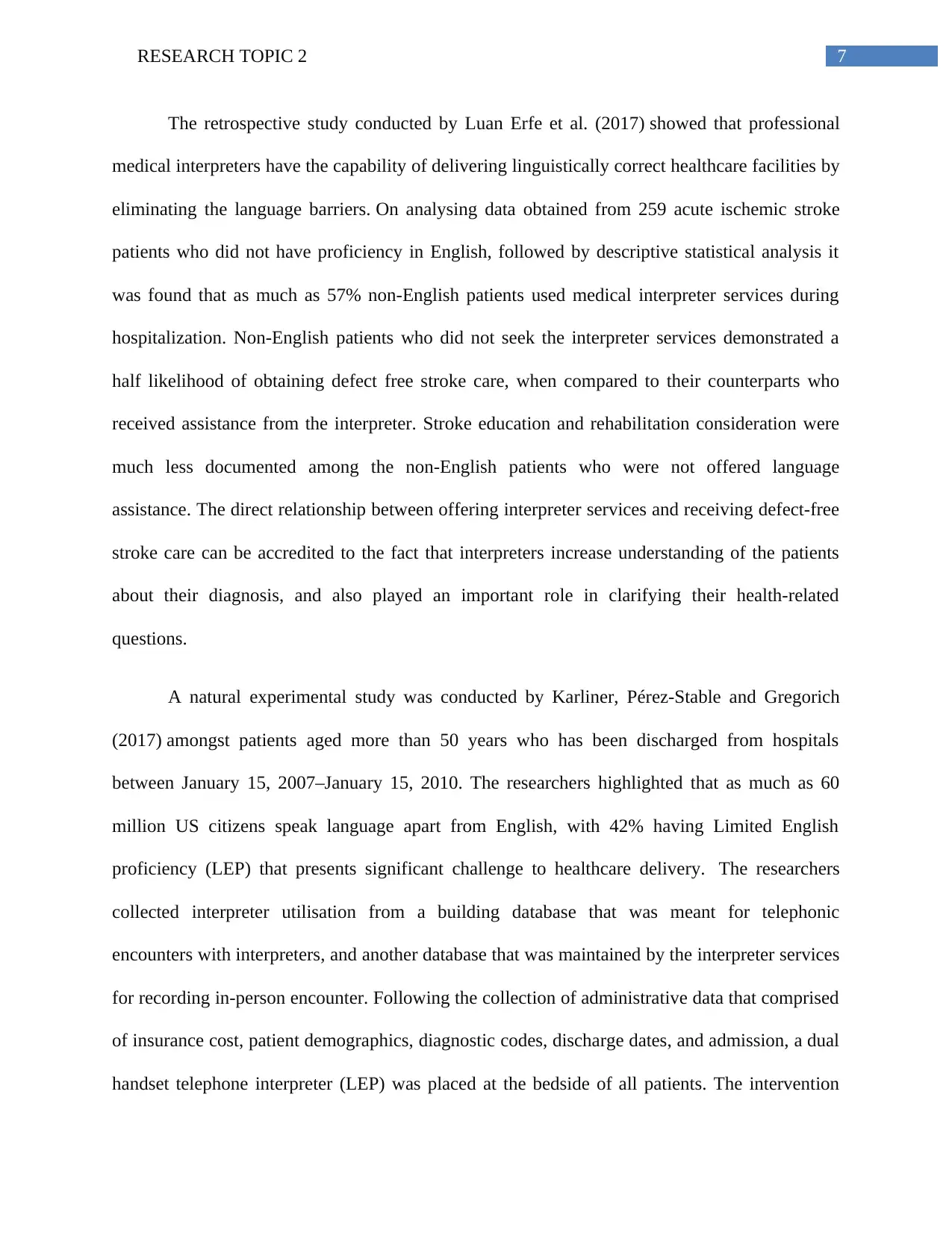
7RESEARCH TOPIC 2
The retrospective study conducted by Luan Erfe et al. (2017) showed that professional
medical interpreters have the capability of delivering linguistically correct healthcare facilities by
eliminating the language barriers. On analysing data obtained from 259 acute ischemic stroke
patients who did not have proficiency in English, followed by descriptive statistical analysis it
was found that as much as 57% non-English patients used medical interpreter services during
hospitalization. Non-English patients who did not seek the interpreter services demonstrated a
half likelihood of obtaining defect free stroke care, when compared to their counterparts who
received assistance from the interpreter. Stroke education and rehabilitation consideration were
much less documented among the non-English patients who were not offered language
assistance. The direct relationship between offering interpreter services and receiving defect-free
stroke care can be accredited to the fact that interpreters increase understanding of the patients
about their diagnosis, and also played an important role in clarifying their health-related
questions.
A natural experimental study was conducted by Karliner, Pérez-Stable and Gregorich
(2017) amongst patients aged more than 50 years who has been discharged from hospitals
between January 15, 2007–January 15, 2010. The researchers highlighted that as much as 60
million US citizens speak language apart from English, with 42% having Limited English
proficiency (LEP) that presents significant challenge to healthcare delivery. The researchers
collected interpreter utilisation from a building database that was meant for telephonic
encounters with interpreters, and another database that was maintained by the interpreter services
for recording in-person encounter. Following the collection of administrative data that comprised
of insurance cost, patient demographics, diagnostic codes, discharge dates, and admission, a dual
handset telephone interpreter (LEP) was placed at the bedside of all patients. The intervention
The retrospective study conducted by Luan Erfe et al. (2017) showed that professional
medical interpreters have the capability of delivering linguistically correct healthcare facilities by
eliminating the language barriers. On analysing data obtained from 259 acute ischemic stroke
patients who did not have proficiency in English, followed by descriptive statistical analysis it
was found that as much as 57% non-English patients used medical interpreter services during
hospitalization. Non-English patients who did not seek the interpreter services demonstrated a
half likelihood of obtaining defect free stroke care, when compared to their counterparts who
received assistance from the interpreter. Stroke education and rehabilitation consideration were
much less documented among the non-English patients who were not offered language
assistance. The direct relationship between offering interpreter services and receiving defect-free
stroke care can be accredited to the fact that interpreters increase understanding of the patients
about their diagnosis, and also played an important role in clarifying their health-related
questions.
A natural experimental study was conducted by Karliner, Pérez-Stable and Gregorich
(2017) amongst patients aged more than 50 years who has been discharged from hospitals
between January 15, 2007–January 15, 2010. The researchers highlighted that as much as 60
million US citizens speak language apart from English, with 42% having Limited English
proficiency (LEP) that presents significant challenge to healthcare delivery. The researchers
collected interpreter utilisation from a building database that was meant for telephonic
encounters with interpreters, and another database that was maintained by the interpreter services
for recording in-person encounter. Following the collection of administrative data that comprised
of insurance cost, patient demographics, diagnostic codes, discharge dates, and admission, a dual
handset telephone interpreter (LEP) was placed at the bedside of all patients. The intervention
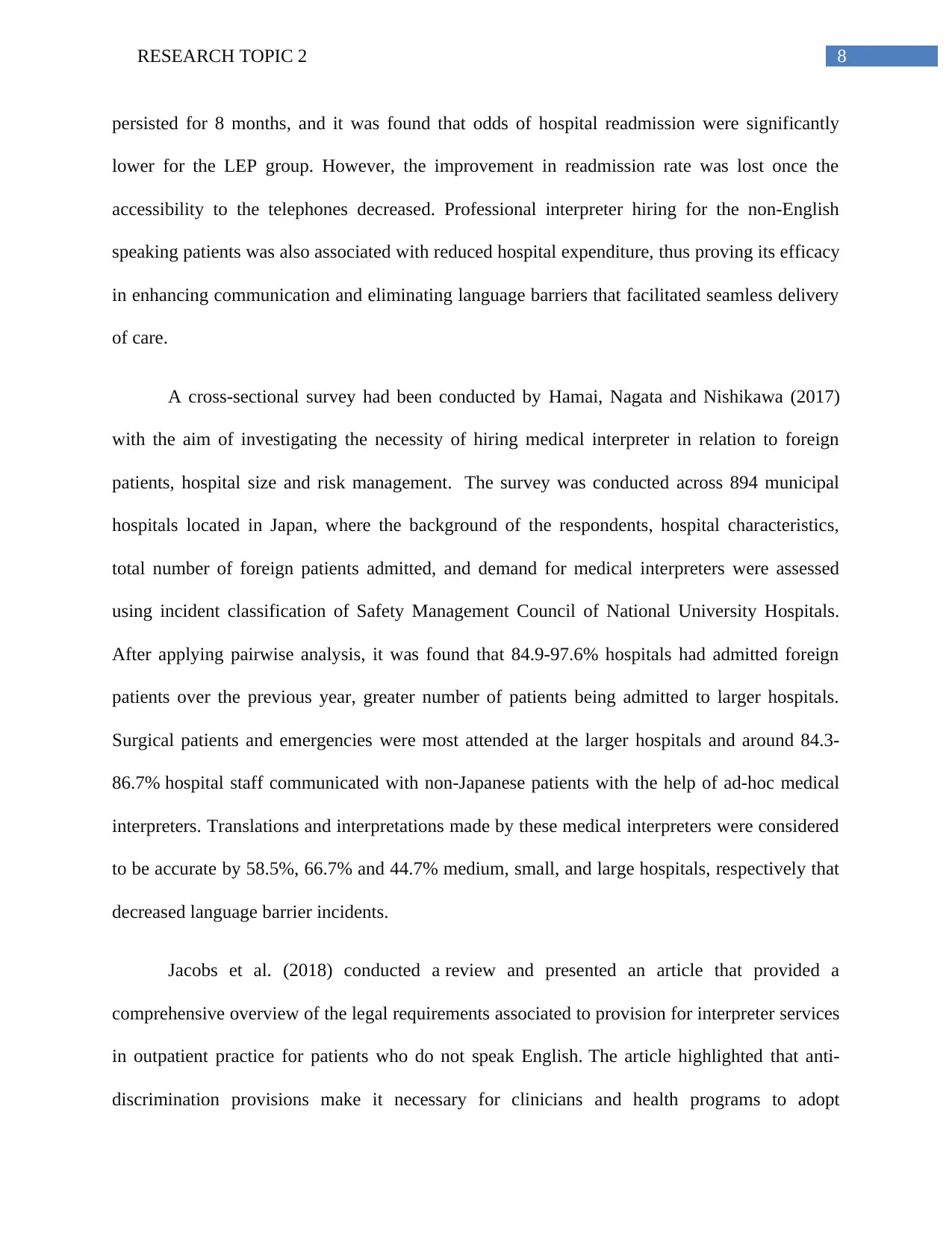
8RESEARCH TOPIC 2
persisted for 8 months, and it was found that odds of hospital readmission were significantly
lower for the LEP group. However, the improvement in readmission rate was lost once the
accessibility to the telephones decreased. Professional interpreter hiring for the non-English
speaking patients was also associated with reduced hospital expenditure, thus proving its efficacy
in enhancing communication and eliminating language barriers that facilitated seamless delivery
of care.
A cross-sectional survey had been conducted by Hamai, Nagata and Nishikawa (2017)
with the aim of investigating the necessity of hiring medical interpreter in relation to foreign
patients, hospital size and risk management. The survey was conducted across 894 municipal
hospitals located in Japan, where the background of the respondents, hospital characteristics,
total number of foreign patients admitted, and demand for medical interpreters were assessed
using incident classification of Safety Management Council of National University Hospitals.
After applying pairwise analysis, it was found that 84.9-97.6% hospitals had admitted foreign
patients over the previous year, greater number of patients being admitted to larger hospitals.
Surgical patients and emergencies were most attended at the larger hospitals and around 84.3-
86.7% hospital staff communicated with non-Japanese patients with the help of ad-hoc medical
interpreters. Translations and interpretations made by these medical interpreters were considered
to be accurate by 58.5%, 66.7% and 44.7% medium, small, and large hospitals, respectively that
decreased language barrier incidents.
Jacobs et al. (2018) conducted a review and presented an article that provided a
comprehensive overview of the legal requirements associated to provision for interpreter services
in outpatient practice for patients who do not speak English. The article highlighted that anti-
discrimination provisions make it necessary for clinicians and health programs to adopt
persisted for 8 months, and it was found that odds of hospital readmission were significantly
lower for the LEP group. However, the improvement in readmission rate was lost once the
accessibility to the telephones decreased. Professional interpreter hiring for the non-English
speaking patients was also associated with reduced hospital expenditure, thus proving its efficacy
in enhancing communication and eliminating language barriers that facilitated seamless delivery
of care.
A cross-sectional survey had been conducted by Hamai, Nagata and Nishikawa (2017)
with the aim of investigating the necessity of hiring medical interpreter in relation to foreign
patients, hospital size and risk management. The survey was conducted across 894 municipal
hospitals located in Japan, where the background of the respondents, hospital characteristics,
total number of foreign patients admitted, and demand for medical interpreters were assessed
using incident classification of Safety Management Council of National University Hospitals.
After applying pairwise analysis, it was found that 84.9-97.6% hospitals had admitted foreign
patients over the previous year, greater number of patients being admitted to larger hospitals.
Surgical patients and emergencies were most attended at the larger hospitals and around 84.3-
86.7% hospital staff communicated with non-Japanese patients with the help of ad-hoc medical
interpreters. Translations and interpretations made by these medical interpreters were considered
to be accurate by 58.5%, 66.7% and 44.7% medium, small, and large hospitals, respectively that
decreased language barrier incidents.
Jacobs et al. (2018) conducted a review and presented an article that provided a
comprehensive overview of the legal requirements associated to provision for interpreter services
in outpatient practice for patients who do not speak English. The article highlighted that anti-
discrimination provisions make it necessary for clinicians and health programs to adopt
⊘ This is a preview!⊘
Do you want full access?
Subscribe today to unlock all pages.

Trusted by 1+ million students worldwide
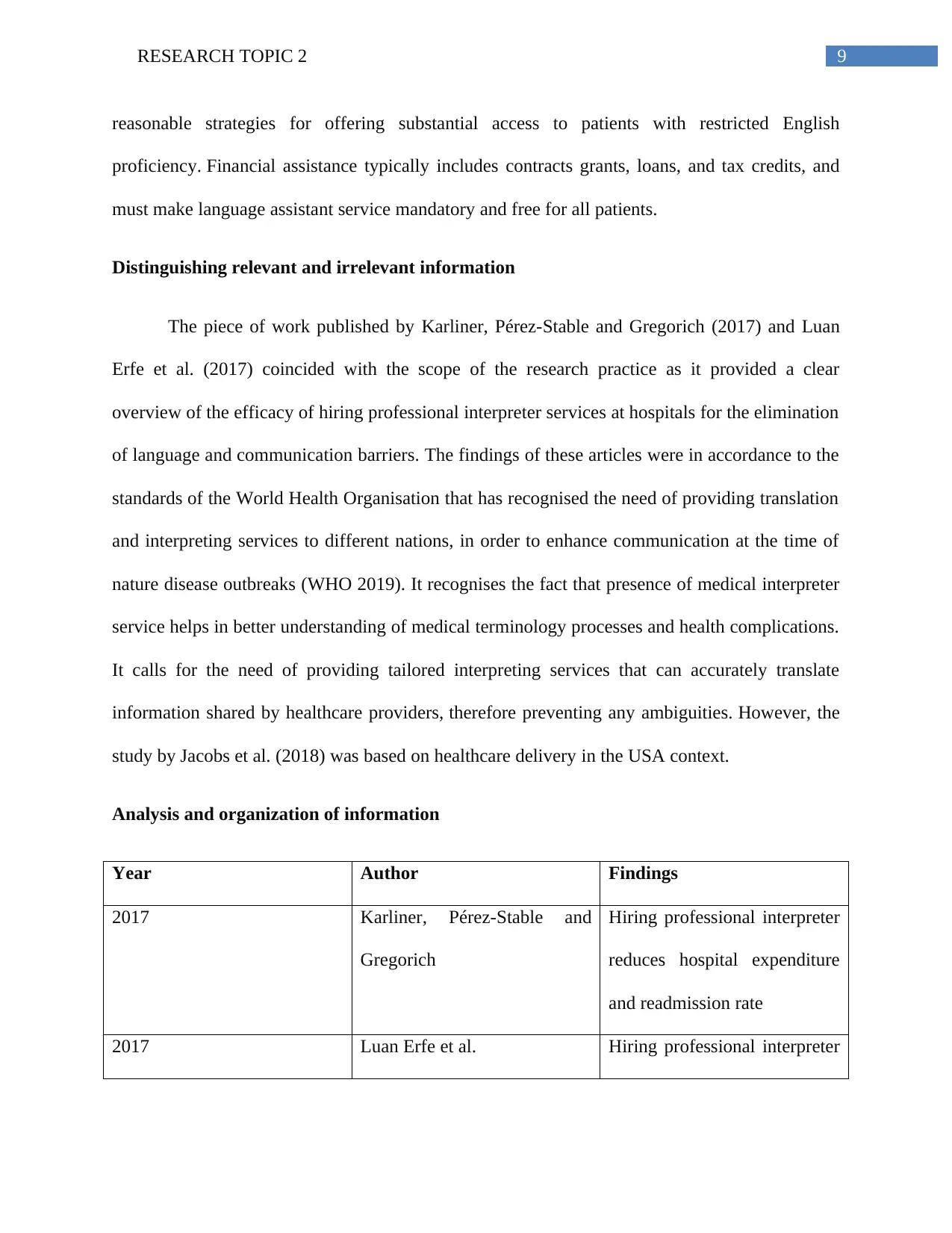
9RESEARCH TOPIC 2
reasonable strategies for offering substantial access to patients with restricted English
proficiency. Financial assistance typically includes contracts grants, loans, and tax credits, and
must make language assistant service mandatory and free for all patients.
Distinguishing relevant and irrelevant information
The piece of work published by Karliner, Pérez-Stable and Gregorich (2017) and Luan
Erfe et al. (2017) coincided with the scope of the research practice as it provided a clear
overview of the efficacy of hiring professional interpreter services at hospitals for the elimination
of language and communication barriers. The findings of these articles were in accordance to the
standards of the World Health Organisation that has recognised the need of providing translation
and interpreting services to different nations, in order to enhance communication at the time of
nature disease outbreaks (WHO 2019). It recognises the fact that presence of medical interpreter
service helps in better understanding of medical terminology processes and health complications.
It calls for the need of providing tailored interpreting services that can accurately translate
information shared by healthcare providers, therefore preventing any ambiguities. However, the
study by Jacobs et al. (2018) was based on healthcare delivery in the USA context.
Analysis and organization of information
Year Author Findings
2017 Karliner, Pérez-Stable and
Gregorich
Hiring professional interpreter
reduces hospital expenditure
and readmission rate
2017 Luan Erfe et al. Hiring professional interpreter
reasonable strategies for offering substantial access to patients with restricted English
proficiency. Financial assistance typically includes contracts grants, loans, and tax credits, and
must make language assistant service mandatory and free for all patients.
Distinguishing relevant and irrelevant information
The piece of work published by Karliner, Pérez-Stable and Gregorich (2017) and Luan
Erfe et al. (2017) coincided with the scope of the research practice as it provided a clear
overview of the efficacy of hiring professional interpreter services at hospitals for the elimination
of language and communication barriers. The findings of these articles were in accordance to the
standards of the World Health Organisation that has recognised the need of providing translation
and interpreting services to different nations, in order to enhance communication at the time of
nature disease outbreaks (WHO 2019). It recognises the fact that presence of medical interpreter
service helps in better understanding of medical terminology processes and health complications.
It calls for the need of providing tailored interpreting services that can accurately translate
information shared by healthcare providers, therefore preventing any ambiguities. However, the
study by Jacobs et al. (2018) was based on healthcare delivery in the USA context.
Analysis and organization of information
Year Author Findings
2017 Karliner, Pérez-Stable and
Gregorich
Hiring professional interpreter
reduces hospital expenditure
and readmission rate
2017 Luan Erfe et al. Hiring professional interpreter
Paraphrase This Document
Need a fresh take? Get an instant paraphrase of this document with our AI Paraphraser
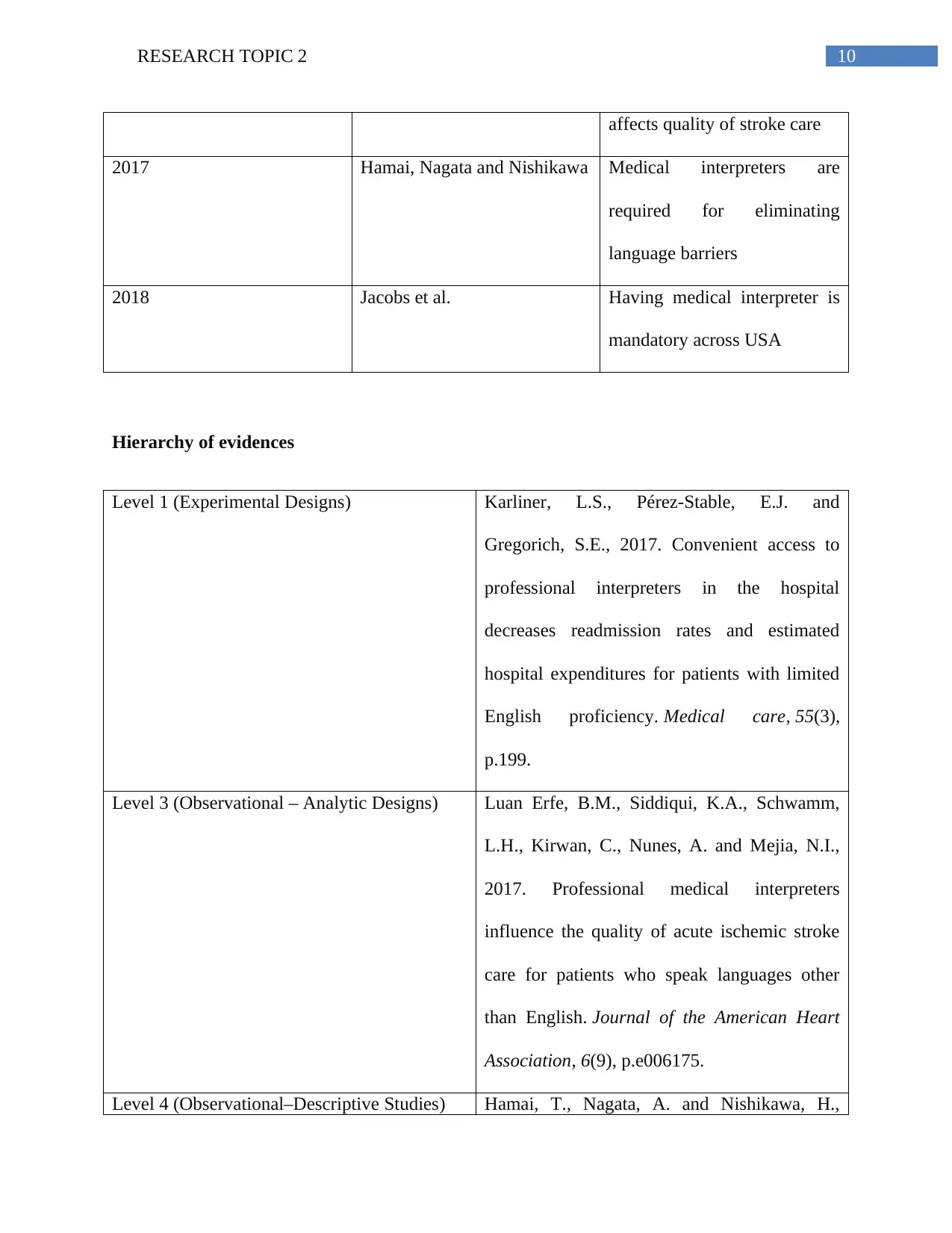
10RESEARCH TOPIC 2
affects quality of stroke care
2017 Hamai, Nagata and Nishikawa Medical interpreters are
required for eliminating
language barriers
2018 Jacobs et al. Having medical interpreter is
mandatory across USA
Hierarchy of evidences
Level 1 (Experimental Designs) Karliner, L.S., Pérez-Stable, E.J. and
Gregorich, S.E., 2017. Convenient access to
professional interpreters in the hospital
decreases readmission rates and estimated
hospital expenditures for patients with limited
English proficiency. Medical care, 55(3),
p.199.
Level 3 (Observational – Analytic Designs) Luan Erfe, B.M., Siddiqui, K.A., Schwamm,
L.H., Kirwan, C., Nunes, A. and Mejia, N.I.,
2017. Professional medical interpreters
influence the quality of acute ischemic stroke
care for patients who speak languages other
than English. Journal of the American Heart
Association, 6(9), p.e006175.
Level 4 (Observational–Descriptive Studies) Hamai, T., Nagata, A. and Nishikawa, H.,
affects quality of stroke care
2017 Hamai, Nagata and Nishikawa Medical interpreters are
required for eliminating
language barriers
2018 Jacobs et al. Having medical interpreter is
mandatory across USA
Hierarchy of evidences
Level 1 (Experimental Designs) Karliner, L.S., Pérez-Stable, E.J. and
Gregorich, S.E., 2017. Convenient access to
professional interpreters in the hospital
decreases readmission rates and estimated
hospital expenditures for patients with limited
English proficiency. Medical care, 55(3),
p.199.
Level 3 (Observational – Analytic Designs) Luan Erfe, B.M., Siddiqui, K.A., Schwamm,
L.H., Kirwan, C., Nunes, A. and Mejia, N.I.,
2017. Professional medical interpreters
influence the quality of acute ischemic stroke
care for patients who speak languages other
than English. Journal of the American Heart
Association, 6(9), p.e006175.
Level 4 (Observational–Descriptive Studies) Hamai, T., Nagata, A. and Nishikawa, H.,
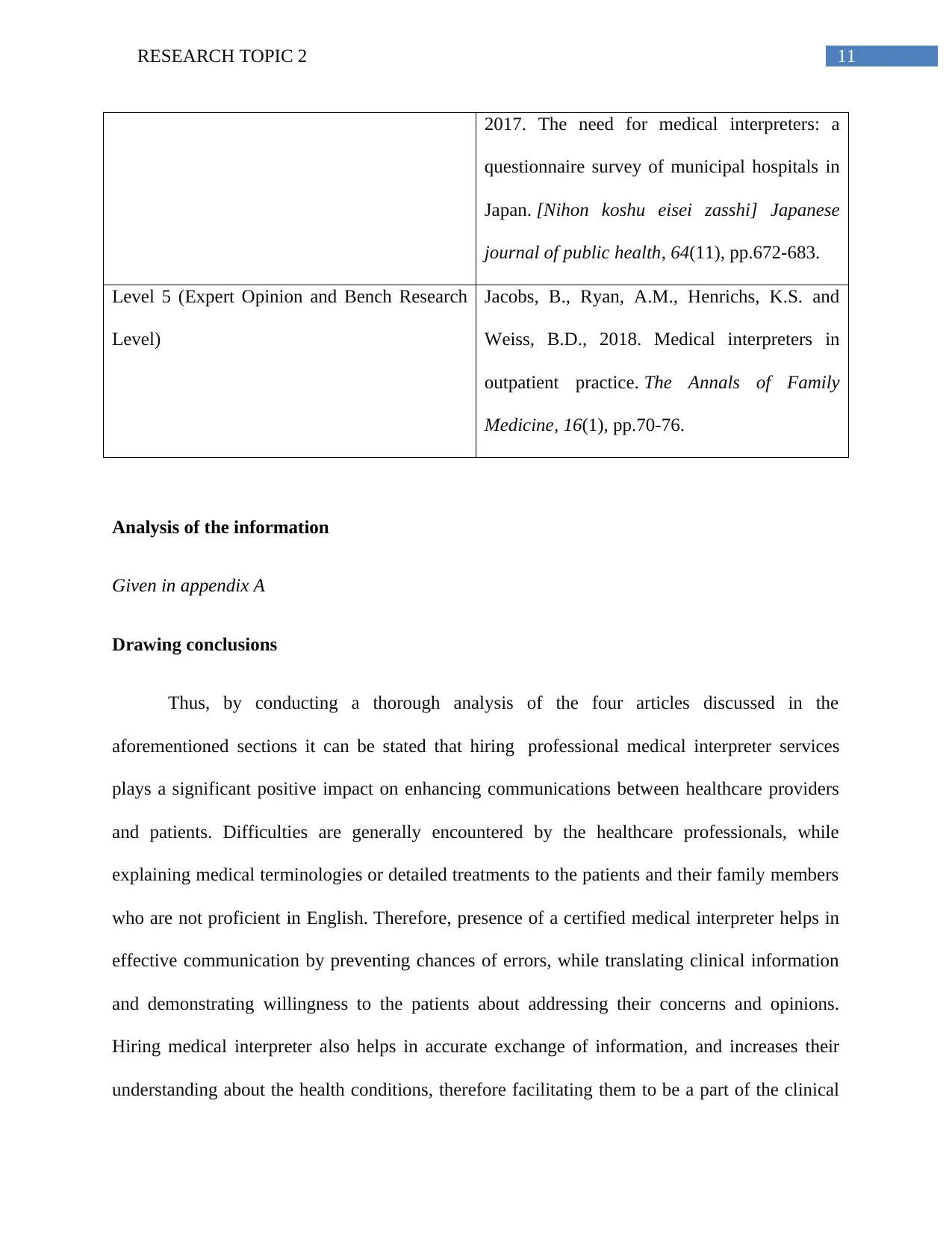
11RESEARCH TOPIC 2
2017. The need for medical interpreters: a
questionnaire survey of municipal hospitals in
Japan. [Nihon koshu eisei zasshi] Japanese
journal of public health, 64(11), pp.672-683.
Level 5 (Expert Opinion and Bench Research
Level)
Jacobs, B., Ryan, A.M., Henrichs, K.S. and
Weiss, B.D., 2018. Medical interpreters in
outpatient practice. The Annals of Family
Medicine, 16(1), pp.70-76.
Analysis of the information
Given in appendix A
Drawing conclusions
Thus, by conducting a thorough analysis of the four articles discussed in the
aforementioned sections it can be stated that hiring professional medical interpreter services
plays a significant positive impact on enhancing communications between healthcare providers
and patients. Difficulties are generally encountered by the healthcare professionals, while
explaining medical terminologies or detailed treatments to the patients and their family members
who are not proficient in English. Therefore, presence of a certified medical interpreter helps in
effective communication by preventing chances of errors, while translating clinical information
and demonstrating willingness to the patients about addressing their concerns and opinions.
Hiring medical interpreter also helps in accurate exchange of information, and increases their
understanding about the health conditions, therefore facilitating them to be a part of the clinical
2017. The need for medical interpreters: a
questionnaire survey of municipal hospitals in
Japan. [Nihon koshu eisei zasshi] Japanese
journal of public health, 64(11), pp.672-683.
Level 5 (Expert Opinion and Bench Research
Level)
Jacobs, B., Ryan, A.M., Henrichs, K.S. and
Weiss, B.D., 2018. Medical interpreters in
outpatient practice. The Annals of Family
Medicine, 16(1), pp.70-76.
Analysis of the information
Given in appendix A
Drawing conclusions
Thus, by conducting a thorough analysis of the four articles discussed in the
aforementioned sections it can be stated that hiring professional medical interpreter services
plays a significant positive impact on enhancing communications between healthcare providers
and patients. Difficulties are generally encountered by the healthcare professionals, while
explaining medical terminologies or detailed treatments to the patients and their family members
who are not proficient in English. Therefore, presence of a certified medical interpreter helps in
effective communication by preventing chances of errors, while translating clinical information
and demonstrating willingness to the patients about addressing their concerns and opinions.
Hiring medical interpreter also helps in accurate exchange of information, and increases their
understanding about the health conditions, therefore facilitating them to be a part of the clinical
⊘ This is a preview!⊘
Do you want full access?
Subscribe today to unlock all pages.

Trusted by 1+ million students worldwide
1 out of 22
Related Documents
Your All-in-One AI-Powered Toolkit for Academic Success.
+13062052269
info@desklib.com
Available 24*7 on WhatsApp / Email
![[object Object]](/_next/static/media/star-bottom.7253800d.svg)
Unlock your academic potential
Copyright © 2020–2025 A2Z Services. All Rights Reserved. Developed and managed by ZUCOL.





